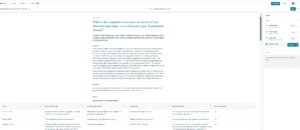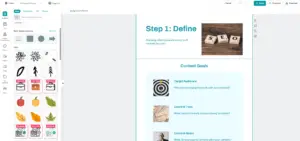A thought leadership campaign is usually an ambitious and demanding marketing project.
As you want to bring the most compelling insights to your audience, it makes sense to set high-quality standards and hold your team accountable to them.
But how to ensure your thought leadership campaign delivers its promise with your limited resources and talents at hand?
Here are some hands-on recommendations to keep your thought leadership on track.
What makes a great thought leadership campaign?
Thought leadership success is often measured by the quality of its output. The better material you produce, the better marketing results you get.
Yet, when it comes to actually planning your campaign, there are many other factors at stake :
- Excellent calibration between your audience’s interests and your thought leadership topic.
- Interesting and robust research.
- Eye-appealing and memorable design.
- Practical and value-adding guidance.
- Multichannel content activation.
In the end, your thought leadership’s success lies not only in your ability to define the right project vision but also in the way you execute this vision with your team and promote your material.
And all this depends on the decisions you’re going to make.
Thought Leadership Best Practices: 8 Recommendations
Thought leadership is already an old business practice. Firms from many industries – whether consulting, tech, or marketing- have long been used to craft high-quality content destined for B2B decision-makers. And even with the emergence of digital publications, thought leadership campaigns still rely on the same timeless values: relevance and timing.
Here’s what that means through 8 best practices:
#1 Consider your marketing purpose
Like any other marketing initiative, a thought leadership campaign should be based on the outcome you’re looking for. You should have a precise picture of the goal you want to reach. This will help you fund your project, mobilize your team and measure the success of your content. For a head of content or marketing, there are many goals to keep in mind :
- Brand awareness and reputation: enhance your brand visibility on key subjects.
- Rebranding: aligning your brands to a new product line or business challenge.
- Lead generation and sales enablement: sparking new conversations with prospective clients and staying top of mind in the sales process.
- Customer loyalty: predicting new customer expectations and being at the forefront of industry best practices.
- Event promotion: supporting your event via a theme-based thought leadership campaign.
You should also consider closely the ideal audience that you want to target. Usually, you want to address your thought leadership content to top decision-makers. But there are many types of executives in companies that have all their own priorities and business interests :
- CEOs that want to drive the growth of their company.
- CFOs that value spending and revenue optimization.
- CMOs that want to align their brand vision with their company’s goals.
- CTOs that seek to deliver business value via their company IT infrastructure.
- Etc…
You have to figure out which types of subjects are keeping them up at night and about which they need reliable material.
#2 Value relevance over originality when choosing your topic
When we hear about “thought leadership”, we usually think about groundbreaking and innovative ideas. But it’s not necessarily so.
In fact, the most compelling thought leadership content talks about topics that are fairly familiar to its audience. The only difference is that they are taking a strong stance on these questions.
Actually, the right thought leadership subject is at the crossroad of 3 things :
- Industry megatrends: prominent issues that are having a long-lasting impact on your industry. For example : technological innovation, demographics, new consumer behaviors, social and political changes…
- Customer hot topics: business issues that are in the mind of your customers right now. For example : new regulations, seasonal sales, external events…
- Company USP: the service, solution, or product that you’re the only ones to deliver to your market or that you deliver the best. The unique expertise that you’ve grown over your industry. For example : a feature of your software that is addressing a specific business issue, the best industrial equipment for specific applications, your unique understanding of the business needs of a specific sector…
Ideally, the best thought leadership topic checks all these requirements. It is both addressing a topic relevant for businesses at the moment, one deeper trend that will long shape the industry, and highlighting your unique expertise.
#3 Start from a strong hypothesis – not from your research
Let’s be real: high-quality thought leadership heavily relies on compelling and robust research. But the empirical results of this research won’t alone help you find an interesting point of view. You first have to decide on a strong hypothesis that will drive your research and help you interpret your findings.
How to find a good research hypothesis?
- Ask the right question. The golden rule is to use the 5-why framework. Start from a common assumption in your industry, and ask yourself why is that so. Do this again and again until you find a new and compelling point of view. For example, why is sustainability important in the finance sector? Because ESG is an ever-pressing issue for companies. Why? Because companies need to take into account their impact on their global environment and make their investment decisions more transparent. Why? Because otherwise, they would be less resilient to their future challenges. Why? Because they will lack an integrated risk management approach, miss new revenue and innovation opportunities, and lose potential talents. This shows how sustainable finance is linked to core business issues.
- Analyze competitive assumptions. In general, many companies have already offered conflicting opinions on your issue. By weighing the points of both sides, you can already make sense of the debate. Assess whether what each side is saying is right and wrong, and leverage critical thinking to draw a middle ground.
- Study the practices of the best-performing and least-performing companies. In every industry, there are winners and losers. By looking at how they are running their business, you can already figure out some interesting insights. Maybe they know better how to facilitate technological adoption in their company, maybe they have a specific method to get product launch right, or maybe they are the best at managing and motivating their talents. Dig a little further and see why is that so.
#4 Opt for other research methods than surveys
When it comes to doing research, the default option often comes to surveying senior executives. But you don’t necessarily need to opt for quantitative research. There are less time-consuming and cost-intensive research methods. You can for example rely on :
- Customer case studies: you might have precious stories and results to share from your own customers.
- SME Interviews: you’ll get a lot of material from in-depth conversations with industry experts.
- Academic papers: sometimes academics have already done the research work for you. You just have to turn these results around so that they support your hypothesis.
- Discussions and Roundtables: bringing professionals together to debate a precise subject can lead to remarkable insights.
- Calculations and extrapolations from open, public, or owned data: you don’t know how much you can already infer from existing data to support your hypothesis.
#5 Leverage Visual Formats
Writing interesting ideas is not enough. Human readers are after all visual creatives- and that’s also the case for top decision-makers. Your executive audience will thank you if you provide them with light and engaging designs that sum up your findings.
You might hire high-quality designers and ask them to enhance your materials with :
- Well-formatted and space-saving text.
- Graphs that present the results of your study.
- Highlighted quotes and comments from experts.
- Infographics that make it easy to share the main takeaways.
#6 Provide practical guidance to your audience
Since you have made already the effort to research the topic, you might as well provide your audience with the main takeaways from your findings. That’s what the most compelling examples of thought leadership content do: they turn their findings into actionable recommendations.
The best way to do this is to draw a visual framework of the solution you propose. You can build a visual model that highlights the key factors of success. This can take the form of a Venn (showing intersections), a Matrix, Circular, Tree, Chart, Workflow diagram.
You can also give step-by-step recommendations to help your audience start reflecting on and applying these changes in their organizations. Supported by relevant success stories and customer testimonials, you’ll help your audience get a clear vision of their potential success.
#7 Ensure quality check of your material
When you prepare a project as ambitious as a thought leadership campaign, it makes sense to set high-quality standards. You want to make a lasting impression on the minds of your prospects and customers. But how to make sure your content is up to the task? While executing, you might find it difficult to take enough distance to assess the quality of your output.
One way is to organize a peer review with all the stakeholders of your project. Define together 6 dimensions against which you want to evaluate your content. For example, it could be topical relevance, design quality, research rigor, practicality… Ask yourself precise questions to ensure it meets the standards and give a score for each dimension. The overall score will tell you if your content passes the bar or not.
That’s a well-established quality control process in consulting firms like Accenture.
#8 Activate through various formats and channels
Thought leadership is all about repetition. The more ways your audience is exposed to your message, the greater your impact on their mind. That’s why you might repurpose your main thought leadership content (white papers, webinars…) into different content formats and promote it through various channels.
By doing that, you also make the most of all the investments you put into your thought leadership project.
You can leverage content format and distribution channels such as :
- Social media posts: Twitter opinion posts, LinkedIn carousel…
- Newsletters: keeping your audience update on the next publications.
- Infographics: design that highlights the most compelling data from your paper.
- Blog Posts: a review of key takeaways of your research.
- Microsite: a custom website that gets all your content initiative together
- Video Interview or webinar: make your subject-matter experts talk about their findings.
With these best practices, you’ll get a head start to launch your first thought leadership campaign!






